Implementing Nature-Based Solutions in Urban Spaces in the Context of the Sense of Danger That Citizens May Feel
Abstract
1. Introduction
- a place that is not maintained, is neglected, or no longer fulfils its function (brownfields);
- a smaller site—ideally up to 0.2 ha but not more than 0.6 ha to allow feasible implementation; or
- a place that spoils the image of its surroundings or even reduces property prices in its vicinity.
2. Pilot Areas in Upper Silesian Coal Basin
2.1. Pilot Area—Ostrava (CZ)
2.2. Pilot Area—The Part of Upper Silesian Agglomeration(PL)
3. Methods
3.1. Methods Applied in Pilote Area Ostrava
3.1.1. Selection of Respondents and Communication Techniques
- Group A—respondents living in housing estates in Ostrava. The group consisted mostly of residents of retirement age. In the Czech Republic, almost 20% [68], of the population is aged 65+. (In this group, there were 3 respondents aged 65–70 and 5 respondents aged 80–85. The other respondents were in the 70–75 and 75–80 age groups). This is a significantly large group of people who tend to be more concerned about crime (analysis).
- Group B—respondents were residents of Ostrava, regardless of the urban district and type of housing, but their age was up to 26 years. (All respondents in this group were aged 20–26). This group of respondents was composed mainly of students. This age group is the least worried about crime [69], but at the same time, they feel very strongly about the problems associated with climate change.
- Group C—respondents were residents of urban districts with a higher crime rate, including residents of the Přívoz district. Respondent age ranged from 26 to 60 years. (The age structure of respondents in this group was: 2 respondents 26–30 years, 4 respondents 35–40 years, 3 respondents 40–45 years, 5 respondents 45–50 years, 1 respondent 55–60 years and 1 respondent 60–65 years.) The reason for the selection was that the area consists of a large number of brownfield sites, with a high perceived crime rate, and is also a place of perceived thermal discomfort (see Figure 1 and Figure 2).
3.1.2. Questionnaire Structure and Method of Processing
3.2. Methods Applied in Pilot Area—The Part of Upper Silesian Agglomeration
4. Results
4.1. Results in Pilot Area Ostrava
4.2. Results in Pilot Area—The Part of Upper Silesia Agglomeration
5. Discussion
6. Conclusions
Author Contributions
Funding
Institutional Review Board Statement
Informed Consent Statement
Data Availability Statement
Acknowledgments
Conflicts of Interest
References
- Anas, A.; Arnott, R.; Small, K. Urban Spatial Structure. J. Econ. Lit. 1998, 36, 1426–1464. Available online: https://www.jstor.org/stable/2564805 (accessed on 17 August 2022).
- Matthews, T. Heat islands: Understanding and mitigating heat in urban areas. Aust. Plan. 2012, 49, 363–364. [Google Scholar] [CrossRef]
- Seto, K.C.; Sánchez-Rodríguez, R.; Fragkias, M. The New Geography of Contemporary Urbanization and the Environment. Annu. Rev. Environ. Resour. 2010, 35, 167–194. [Google Scholar] [CrossRef]
- Xu, R.; Yang, G.; Qu, Z.; Chen, Y.; Liu, J.; Shang, L.; Liu, S.; Ge, Y.; Chang, J. City components—Area relationship and diversity pattern: Towards a better understanding of urban structure. Sustain. Cities Soc. 2020, 60, 102272. [Google Scholar] [CrossRef]
- Gouldson, A.; Colenbrander, S.; Papargyropoulou, A.S.E.; Kerr, N.; McAnulla, F.; Hall, S. Cities and climate change mitigation: Economic opportunities and governance challenges in Asia. Cities 2016, 54, 11–19. [Google Scholar] [CrossRef]
- Storper, M. Governing the large metropolis. Territ. Politics Gov. 2014, 2, 115–134. [Google Scholar] [CrossRef]
- Doyal, L.; Gough, I. A Theory of Human Need; Palgrave Macmillan: Basingstoke, UK, 1991. [Google Scholar] [CrossRef]
- Maslow, A.H. A Theory of Human Motivation. Psychol. Rev. 1943, 50, 370–396. [Google Scholar] [CrossRef]
- Glaeser, E.L. The Triumph of the City: How Our Greatest Invention Makes Us Richer, Smarter, Greener, Healthier, and Happier; Penguin Books: New York, NY, USA, 2011. [Google Scholar]
- Carter, J.G.; Cavan, G.; Conelly, A.; Guy, S.; Handley, J.; Kazmierczak, A. Climate change and the city: Building capacity for urban adaptation. Prog. Plan. 2015, 95, 1–66. [Google Scholar] [CrossRef]
- Rosezweig, C.; Solecki, W.D.; Hammer, S.A.; Mehrotra, S. Climate Change and Cities: First Assessment Report of the Urban Climate Change Research Network, 1st ed.; Cambridge University Press: Cambridge, UK, 2011; p. 312. [Google Scholar] [CrossRef]
- Schär, C.; Vidale, P.L.; Lüthi, D.; Frei, C.; Häberli, C.; Liniger, M.A.; Appenzeller, C. The role of increasing temperature variability in European Summer heatwaves. Nature 2004, 427, 332–336. [Google Scholar] [CrossRef]
- Cardoso, R.; Sobhani, A.; Meijers, E. The cities we need: Towards an urbanism guided by human needs satisfaction. Urban Stud. 2021, 59, 2638–2659. [Google Scholar] [CrossRef]
- Allam, Z.; Bibri, S.E.; Chabaud, D.; Moreno, C. The ‘15-Minute City’ concept can shape a net-zero urban future. Humanit. Soc. Sci. Commun. 2022, 9, 126. [Google Scholar] [CrossRef]
- Bowler, D.E.; Buyung-Ali, L.; Knight, T.M.; Pullin, A.S. Urban greening to cool towns and cities: A systematic review of the empirical evidence. Landsc. Urban Plan. 2010, 97, 147–155. [Google Scholar] [CrossRef]
- Vargo, J.; Habeeb, D.; Stone, B., Jr. The importance of land cover change across urban–rural typologies for climate modeling. J. Environ. Manag. 2013, 114, 243–252. [Google Scholar] [CrossRef] [PubMed]
- Yoon, E.J.; Kim, B.; Lee, D.K. Multi- objective planning model for urban greening based on optimization algorithms. Urban For. Urban Green. 2019, 40, 183–194. [Google Scholar] [CrossRef]
- Dragoni, W.; Sukhija, B. Climate change and groundwater: A short review. Geol. Soc. Spec. Publ. 2008, 288, 1–12. [Google Scholar] [CrossRef]
- Houston, D.; Werritty, A.; Bassett, D.; Geddes, A.; Hoolachan, A.; McMillan, M. Pluvial (Rain-Related) Flooding in Urban Areas: The Invisible Hazard; Joseph Rowntree Foundation: York, UK, 2011; Available online: https://www.jrf.org.uk/report/pluvial-rain-related-flooding-urban-areas-invisible-hazard (accessed on 20 September 2022).
- Shokry, G. Competing risks capes of climate changes, gentrification and adaptation in Philadelphia’s hunting park neighborhood. In Green City and Social Injustice: 21 Tales from North America and Europe, 1st ed.; Anguelovski, I., Connolly, J.J.T., Eds.; Routledge: London, UK, 2021. [Google Scholar]
- Song, Y.; Kirkwood, N.; Maksimović, Č.; Zheng, X.; O’Connor, D.; Jin, Y.; Hou, D. Nature based solutions for contaminated land remediation and brownfield redevelopment in cities: A review. Sci. Total Environ. 2019, 663, 568–579. [Google Scholar] [CrossRef]
- Jafari, E.; Soltanifard, H.; Aliabadi, K.; Karachi, H. Assessment of the Effect of Neyshabur Green Spatial Configuration on the Temperature of Land Surface and Heat Islands. Open J. Ecol. 2017, 7, 554–567. [Google Scholar] [CrossRef][Green Version]
- Santamouris, M.; Kolokotsa, D. Urban Climate Mitigation Techniques, 1st ed.; Routledge: Abingdon, UK, 2016; p. 208. [Google Scholar] [CrossRef]
- Trogrlić, R.Š.; Rijke, J.; Dolman, N.; Zevenbergen, C. Rebuild by Design in Hoboken: A Design Competition as a Means for Achieving Flood Resilience of Urban Areas through the Implementation of Green Infrastructure. Water 2018, 10, 553. [Google Scholar] [CrossRef]
- Cortinovis, C.; Grazia, Z.; Geneletti, D. Assessing Nature-Based Recreation to Support Urban Green Infrastructure Planning in Trento (Italy). Land 2018, 7, 112. [Google Scholar] [CrossRef]
- Van Leeuwen, J.P.; Timmermans, H.J.P. Innovations in Design & Decision Support Systems in Architecture and Urban Planning, 1st ed.; Springer: Dordrecht, The Netherlands, 2006; p. 502. [Google Scholar] [CrossRef]
- Niedźwiecka-Filipiak, I.; Rubaszek, J.; Potyrała, J. The Method of Planning Green Infrastructure System with the Use of Landscape-Functional Units (Method LaFU) and its Implementation in the Wrocław Functional Area (Poland). Sustainability 2019, 11, 394. [Google Scholar] [CrossRef]
- Jansson, M. Green space in compact cities: The benefits and values of urban ecosystem services in planning. Nord. J. Archit. Res. 2014, 2, 139–160. Available online: https://arkitekturforskning.net/na/article/view/498 (accessed on 17 August 2022).
- Kabisch, N.; Strohbach, M.; Haase, D.; Kronenberg, J. Urban green space availability in European cities. Ecol. Indic. 2016, 70, 586–596. [Google Scholar] [CrossRef]
- Bhairappanavar, S.; Liu, R.; Coffman, R. Beneficial Uses of Dredged Material in Green Infrastructure and Living Architecture to Improve Resilience of Lake Erie. Infrastructures 2018, 3, 42. [Google Scholar] [CrossRef]
- Gill, S.E.; Handley, J.F.; Ennos, A.R.; Pauleit, S. Adapting Cities for Climate Change: The role of the Green Infrastructure. In Built Environment, 1st ed.; Gill, S.E., Handley, J.F., Ennos, A.R., Pauleit, S., Eds.; Alexandrine Press: Marcham, UK, 2007; Volume 33, pp. 115–133. [Google Scholar] [CrossRef]
- Infield, E.M.H.; Abunnasr, Y.; Ryan, R.L. Planning for Climate Change: A Reader in Green Infrastructure and Sustainable Design for Resilient Cities, 1st ed.; Routledge: Abingdon, UK, 2018; p. 392. [Google Scholar]
- Loder, A. Small-Scale Urban Greening: Creating Places of Health, Creativity, and Ecological Sustainability, 1st ed.; Routledge: Abingdon, UK, 2020; p. 75. [Google Scholar] [CrossRef]
- Mathey, J.; Rößler, S.; Lehmann, I.; Bräuer, A. Urban Green Spaces: Potentials and Constraints for Urban Adaptation to Climate Change. Resilient Cities 2011, 1, 479–485. [Google Scholar] [CrossRef]
- Rubio-Bellido, C.; Pulido-Arcas, J.A.; Cabeza-Lainez, J.M. Adaptation Strategies and Resilience to Climate Change of Historic Dwellings. Sustainability 2015, 7, 3695–3713. [Google Scholar] [CrossRef]
- Hagen, B. Public Perception of Climate Change: Policy and Communication; Routledge: London, UK, 2016; ISBN 978-138-79523-5. [Google Scholar] [CrossRef]
- Kupka, J. “Za města krásnější.“ Angažmá měšťanské společnosti vokrašlování měst. (“For more beautiful cities.” The engagement of the bourgeois society with urban embellishment.) In Královéhradecko. Historický Sborník pro Poučenou Veřejnost; Muzeum Východních Čech: Králové, Czech Republic, 2010; Volume 7, pp. 67–69. ISBN 978-80-85031-86-7. ISSN 1214-5211. [Google Scholar]
- Indikátory Kvality Života v Oblasti Bezpečnosti (Indicators of Quality of Life in the Field of Safety). Úřad Vlády České Republiky. Available online: https://www.cr2030.cz/strategie/wpcontent/uploads/sites/2/2018/05/11_Bezpe%C4%8Dnost.pdf (accessed on 13 September 2022).
- Lovasi, G.S.; Schwartz-Soicher, O.; Quinn, J.W.; Berger, D.K.; Neckerman, K.M.; Jaslow, R.; Lee, K.K.; Rundle, A. Neighborhood safety and green space as predictors of obesity among preschool children from low-income families in New York City. Prev. Med. 2013, 57, 189–193. Available online: https://pubmed.ncbi.nlm.nih.gov/23732240/ (accessed on 17 August 2022). [CrossRef]
- Ruan, X.; Hogben, P. Topophilia and Topophobia: Reflections on Twentieth Century Human Habitat; Routledge: New York, NY, USA, 2007; 232p. [Google Scholar]
- Cole, H.; Abel, T.D. Resisting green gentrification, Seattle’s South Park neighborhood struggles for environmental justice. In Green City and Social Injustice: 21 Tales from North America and Europe, 1st ed.; Anguelovski, I., Connolly, J.J.T., Eds.; Routledge: New York, NY, USA, 2021. [Google Scholar]
- Bolger, N.; Zuckerman, A. A framework for studying personality in the stress process. J. Pers. Soc. Psychol. 1995, 69, 890–902. [Google Scholar] [CrossRef]
- Tomášek, J. Úvod do Kriminologie: JAK Studovat Zločin; (Introduction to Criminology: How to Study Crime); Grada: Praha, Czech Republic, 2010; ISBN 978-80-247-2982-4. [Google Scholar]
- Jíchová, J.; Temelová, J. Kriminalita a její percepce ve vnitřním městě: Případová studie pražského Žižkova a Jarova (Crime and its perception in the inner city: A case study of Prague’s Žižkov and Jarov). Geografie 2012, 117, 329–348. [Google Scholar] [CrossRef]
- Jíchová, J.; Temelová, J. Kriminalita a riziková místa centrálního a vnitřního města: Sonda do názorů obyvatel vybraných pražských čtvrtí (Crime and risky places of the central and inner city: A probe into the opinions of the inhabitants of selected Prague districts). In Nové Sociálně Prostorové Nerovnosti, Lokální Rozvoj a Kvalita Života; Temelová, J., Pospíšilová, L., Ouředníček, M., Eds.; Aleš Čeněk: Plzeň, Czech Republic, 2012; pp. 46–76. [Google Scholar]
- Krulichová, E.; Buriánek, J. (Eds.) Obavy ze Zločinu: Mýty a Realita (Fears of Crime: Myths and Reality); Karolinum: Praha, Czech Republic, 2020. [Google Scholar]
- Toušek, L.; Hejnal, O. Analýza Pocitu Bezpečí Občanů Vybraných Obcí Plzeňského Kraje (Analysis of the Feeling of Security of Citizens of Selected Municipalities of the Pilsen Region); Krajský Úřad Plzeňského Kraje: Pilsen, Czech Republic, 2011. [Google Scholar]
- Fisher, B.S.; Nasar, J.L. Fear of Crime in Relation to Three Exterior Site Features. Prospect, Refuge, and Escape. Environ. Behav. 1992, 24, 35–65. [Google Scholar] [CrossRef]
- Zoophobia (Fear of Animals). Cleveland Clinics. Available online: https://my.clevelandclinic.org/health/diseases/22727-zoophobia-fear-of-animals (accessed on 13 September 2022).
- Entomophobia (Fear of Insects). Cleveland Clinics. Available online: https://my.clevelandclinic.org/health/diseases/22551-entomophobia-fear-of-insects (accessed on 13 September 2022).
- Ornithophobia (Fear of Birds). Cleveland Clinics. Available online: https://my.clevelandclinic.org/health/diseases/22533-ornithophobia-fear-of-birds (accessed on 13 September 2022).
- Gastaldi, F.; Camerin, F. Brownfield infrastructures. In The Elgar Companion to Urban Infrastructure Governance Innovation, Concepts and Cases; Finger, M., Yanar, N., Eds.; Edward Elgar Publishing Limited: Cheltenham, UK; Northampton, MA, USA, 2022. [Google Scholar] [CrossRef]
- Rink, D.; Schmidt, C. Afforestation of Urban Brownfields as a Nature-Based Solution. Experiences from a Project in Leipzig (Germany). Land 2021, 10, 893. [Google Scholar] [CrossRef]
- Český Statistický Úřad (Czech Statistical Office). Available online: https://www.czso.cz/csu/czso/databaze-demografickych-udaju-za-vybrana-mesta-cr (accessed on 18 April 2022).
- Eckart, K.; Ehrke, S. Social, Economic and Cultural Aspects in the Dynamic Changing Process of Old Industrial Regions: Ruhr District (Germany), Upper Silesia (Poland), Ostrava Region (Czech Republic); Lit Verlag Münster: Münster, Germany, 2003; Volume 1, p. 277. [Google Scholar]
- Jiřík, K. Dějiny Města Ostravy. (History of Ostrava); Sfinga: Ostrava, Czech Republic, 1993. [Google Scholar]
- Český Statistický Úřad (Czech Statistical Office). Available online: https://www.czso.cz/csu/xt/charakteristika_okresu_ostrava_mesto (accessed on 15 February 2021).
- Vize Prostorového Rozvoje Ostravy. Available online: https://vize-prostoroveho-rozvoje-mappaova.hub.arcgis.com/ (accessed on 12 March 2022).
- ZdravaOstrava—Oficiální Web Města Ostravy k Životnímu Prostředí- Příroda a biodiverzita. (The Official Website of the City of Ostrava Devoted to the Environment- Nature and Biodiversity). Available online: https://zdravaova.cz/category/priroda-a-biodiverzita/ (accessed on 25 September 2022).
- ZdravaOstrava—Oficiální Web Města Ostravy k Životnímu Prostředí -Adaptační Strategie na Dopady a Rizika, Vyplývající ze Změny Klimatu. (The Official Website of the City of OSTRAVA Devoted to the Environment—Adaptation Strategies to Climate Change Impacts and Risks). Available online: https://zdravaova.cz/adaptacni-strategie-na-zmeny-klimatu/ (accessed on 25 September 2022).
- FajnOva—Oficiální Web Města Ostravy k Strategickému Plánování. (The Official Website of the City of Ostrava for the Strategical Planning). Available online: https://fajnova.cz/pocitova-mapa (accessed on 1 October 2020).
- Internal Documents ARR (MSID). Regional Development Agency Now Moravian Silesian Investment and Development (Interní Materiál k Přípravě Databáze Brownfieldů. (Internal Material for the Preparation of a Database of Brownfields)). 2020 Unpublished work. p. 26.
- Mekjavic, I.B.; Yogev, D.; Ciuha, U. Perception of Thermal Comfort during Skin Cooling and Heating. Life 2021, 11, 681. [Google Scholar] [CrossRef] [PubMed]
- Schweiker, M.; Huebner, G.M.; Kingma, B.R.M.; Kramer, R.; Pallubinsky, H. Drivers of diversity in human thermal perception—A Review for Holistic Comfort Models. Temperature 2018, 5, 308–342. [Google Scholar] [CrossRef] [PubMed]
- Orcígr, V.; Vidovićová, L.; Šerák, M.; Fernandová, E. Pražští Senioři a Extrémní Horka (Prague Seniors and Extreme Heat). Arnika 2020. Available online: https://www.rds.org.co/apc-aa-files/205ec78c9cca6d1850bdca24e20e50bf/arnika_studie_seniori.pdf (accessed on 25 September 2022).
- Kalvach, Z.; Zadák, Z.; Jirák, R.; Sucharda, P.; Zavázalová, H. Geriatrie a Gerontologie (Geriatrie and Gerontologie); Grada: Praha, Czech Republic, 2004; Volume 567. [Google Scholar]
- Fudała, M. Urban environmental acupuncture for improving access to green spaces in cities—Example from urban region in Central Europe. In Integrated Environmental Management of Land and Soil in European Urban Areas; Starzewska-Sikorska, A., Ed.; Polish Academy of Sciences: Warsaw, Poland, 2021. [Google Scholar]
- Český Statistický Úřad (Czech Statistical Office). Available online: https://www.czso.cz/staticke/animgraf/cz080/index.html?lang=cz (accessed on 12 April 2022).
- Braungart, M.M.; Braungart, R.G.; Hoyer, W.J. Age, Sex, and Social Factors in Fear of Crime. Sociol. Focus 1980, 13, 55–66. [Google Scholar] [CrossRef]
- Baruch, E.M.; Voss, K.A.; Blaszczak, J.R.; Delesantro, J.; Urban, D.L.; Bernhardt, E.S. Not all pavements lead to streams: Variation in impervious surface connectivity affects urban stream ecosystems. Freshw. Sci. 2018, 37, 673–684. [Google Scholar] [CrossRef]
- Burden, D. Urban Street Trees: 22 Benefits, Specific Applications, 1st ed.; Glatting Jackson and Walkable Communities Inc.: Orlando, FL, USA, 2006; pp. 1–21. [Google Scholar]
- Djedjig, R.; Belarbi, R.; Bozonnet, E. Green wall impacts inside and outside buildings: Experimental study. Energy Procedia 2017, 139, 578–583. [Google Scholar] [CrossRef]
- Dolan, L.M.J.; Bohemen, H.; Whelan, P.; Akbar, K.F.; O’Malley, V.; O’Leary, G.; Keizer, P.J. Towards the sustainable development of modern road ecosystems. In Environmental Pollution, The Ecology of Transportation: Managing Mobility for the Environment, 1st ed.; Davenport, J., Davenport, J.L., Eds.; Springer: Dordrecht, The Netherlands, 2006; Volume 10, pp. 275–331. [Google Scholar] [CrossRef]
- Drozd, W. Problems and benefits of using green roofs in Poland. IOP Conf. Ser. Earth Environ. Sci. 2019, 214, 012076. [Google Scholar] [CrossRef]
- Elsadek, M.; Liu, B.; Zefeng, L. Green facades: Their contribution to street recovery and well-being in high-density cities. Urban For. Urban Green. 2019, 46, 126446. [Google Scholar] [CrossRef]
- Lee, K.-W.W.; Vinka, O.-C.; Kohm, S.; Chango, H. Cool Pavements As a Sustainable Approach to Green Streets and Highways. In Proceedings of the Green Streets and Highways Conference 2010, Denver, CO, USA, 14–17 November 2010; American Society of Civil Engineers (ASCE): Reston, VA, USA, 2010; pp. 235–247. [Google Scholar] [CrossRef]
- Leroy, M.-C.; Portet-Koltalo, F.; Legras, M.; Lederf, F.; Moncond’huy, V.; Polaert, I.; Marcotte, S. Performance of vegetated swales for improving road runoff quality in a moderate traffic urban area. Sci. Total Environ. 2016, 566–567, 113–121. [Google Scholar] [CrossRef]
- Li, W.C.; Yeung, K.K.A. A comprehensive study of green roof performance from environmental perspective. Int. J. Sustain. Built Environ. 2014, 3, 127–134. [Google Scholar] [CrossRef]
- Scott, M.; Lennon, M.; Haase, D.; Kazmierczak, A.; Clabby, G.; Beatley, T. Nature-based solutions for the contemporary city/Re-naturing the city/Reflections on urban landscapes, ecosystems services and nature-based solutions in cities/Multifunctional green infrastructure and climate change adaptation: Brownfield greening as an adaptation strategy for vulnerable communities?/Delivering green infrastructure through planning: Insights from practice in Fingal, Ireland/Planning for biophilic cities: From theory to practice. Plan. Theory Pract. 2016, 17, 267–300. [Google Scholar] [CrossRef]
- Soares, A.L.; Rego, F.C.; McPherson, E.G.; Simpson, J.R.; Peper, P.J.; Xiao, Q. Benefits and costs of street trees in Lisbon, Portugal. Urban For. Urban Green. 2011, 10, 69–78. [Google Scholar] [CrossRef]
- Zhang, L.; Zhichao, D.; Liang, L.; Zhang, Y.; Meng, Q.; Wang, J.; Mattheos, S. Thermal behavior of a vertical green façade and its impact on the indoor and outdoor thermal environment. Energy Build. 2019, 204, 109502. [Google Scholar] [CrossRef]
- Clarke, A. Evaluation Research: An Introduction to Principles, Methods and Practice; SAGE: London, UK, 1999. [Google Scholar]
- Stangel, M. Action Plan for UEA in Chorzów, Ruda Śląska and Świętochłowice; SALUTE4CE Project of CE Programme: Vienna, Austria, 2021. [Google Scholar]
- Anguelovski, I.; Connolly, J.J.T. Green City Social Injustice: 21 Tales from North America and Europe, 1st ed.; Routledge: London, UK, 2021. [Google Scholar]
- Kupka, J. Počátky Veřejné Zeleně ve Strakonicích (The Beginnings of Public Greenery in Strakonice). In Vlastivědný Sborník Strakonice 3; Kapitoly ze Života Města. Strakonice: Město Strakonice, Czech Republic, 2005; pp. 251–272. ISBN 80-239-4790-7. [Google Scholar]
- Mathey, J.; Arndt, T.; Banse, J.; Rink, D. Public perception of spontaneous vegetation on brownfields in urban areas—Results from surveys in Dresden and Leipzig (Germany). Urban For. Urban Green. 2016, 29, 384–392. [Google Scholar] [CrossRef]
- Southona, G.E.; Jorgensena, A.; Dunnetta, N.; Hoylea, H.; Evansba, K.L. Biodiverse perennial meadows have aesthetic value and increaseresidents’ perceptions of site quality in urban green-space. Landsc. Urban Plan. 2017, 158, 105–118. [Google Scholar] [CrossRef]
- Norton, B.A.; Bending, G.D.; Clark, R.; Corstanje, R.; Dunnett, N.; Evans, K.L.; Grafius, D.R.; Gravestock, E.; Grice, S.M.; Harris, J.A.; et al. Urban meadows as an alternative to short mown grassland: Effects of composition and height on biodiversity. Ecol. Appl. 2019, 29, e01946. [Google Scholar] [CrossRef]
- Prieto Curiel, R.; Bishop, S.R. Fear of crime: The impact of different distributions of victimisation. Palgrave Commun. 2018, 4, 46. [Google Scholar] [CrossRef]

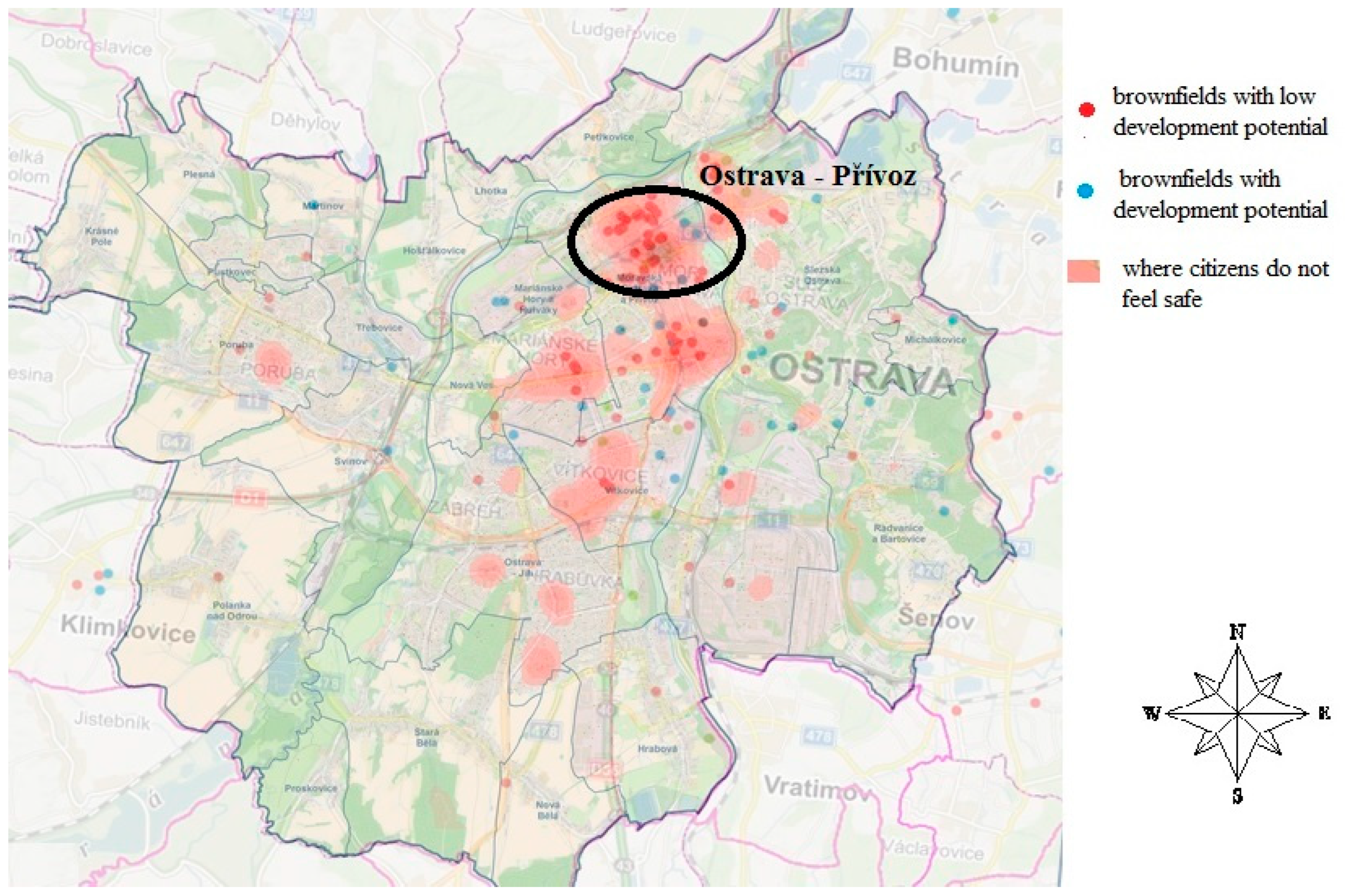
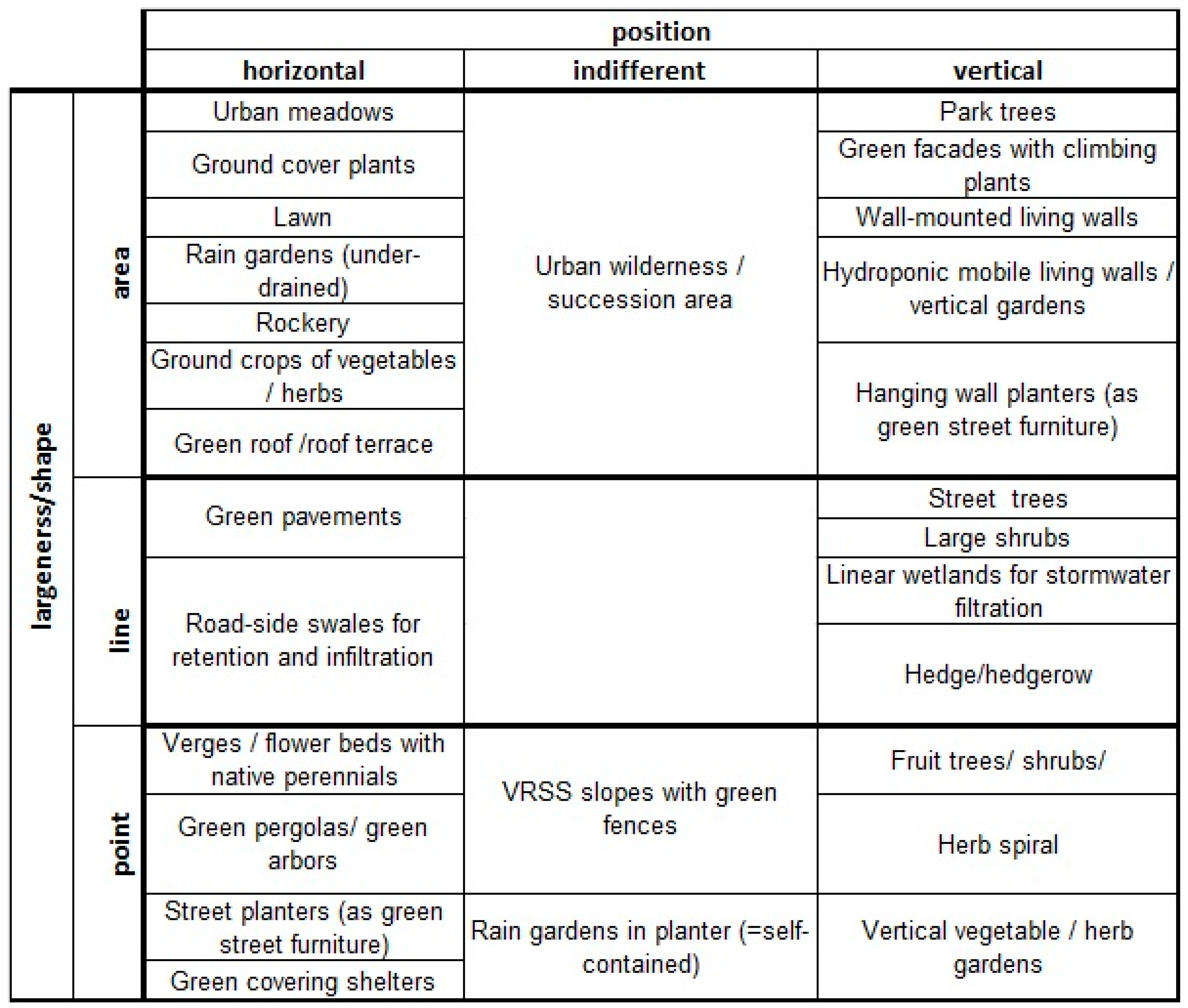

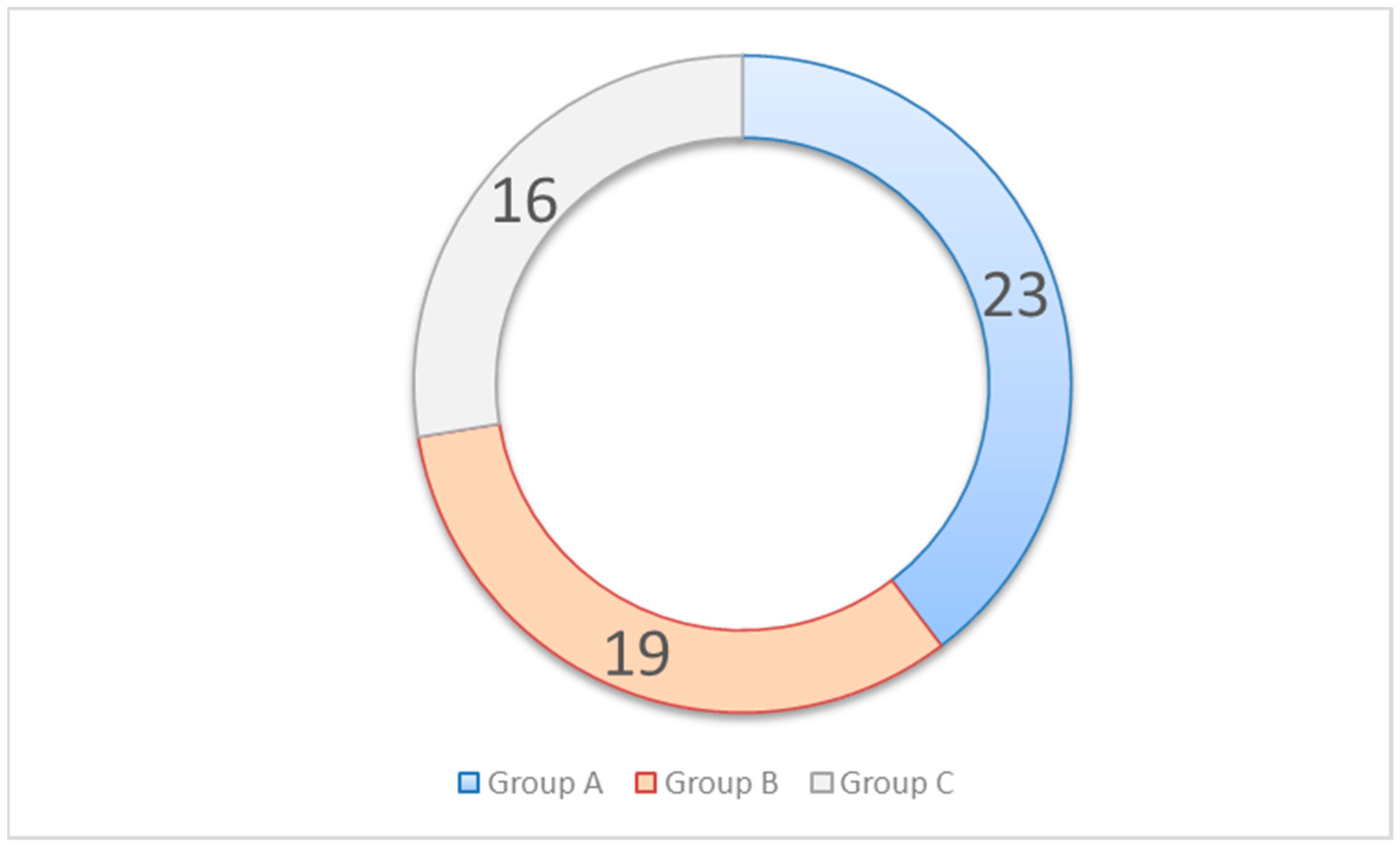
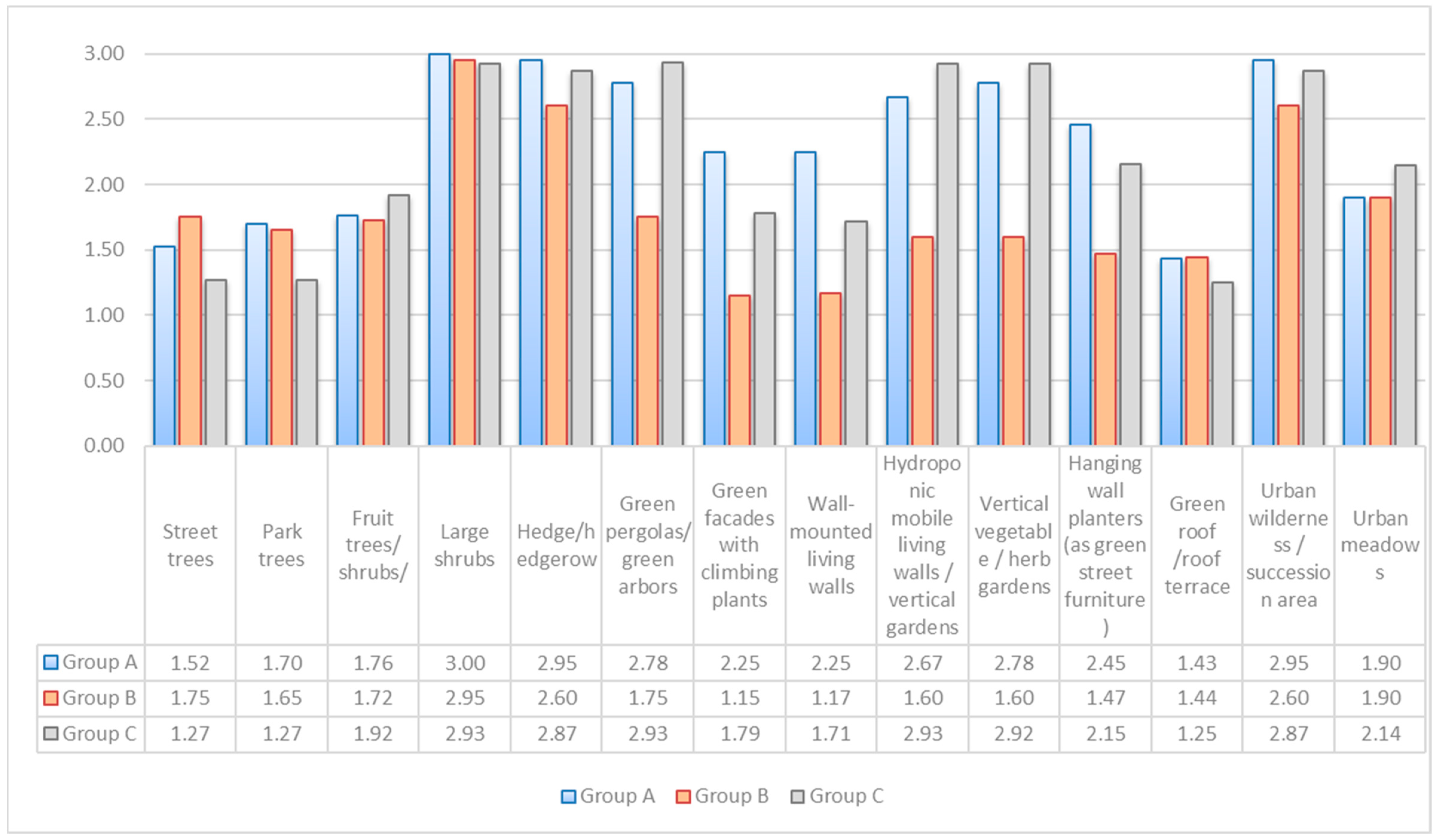

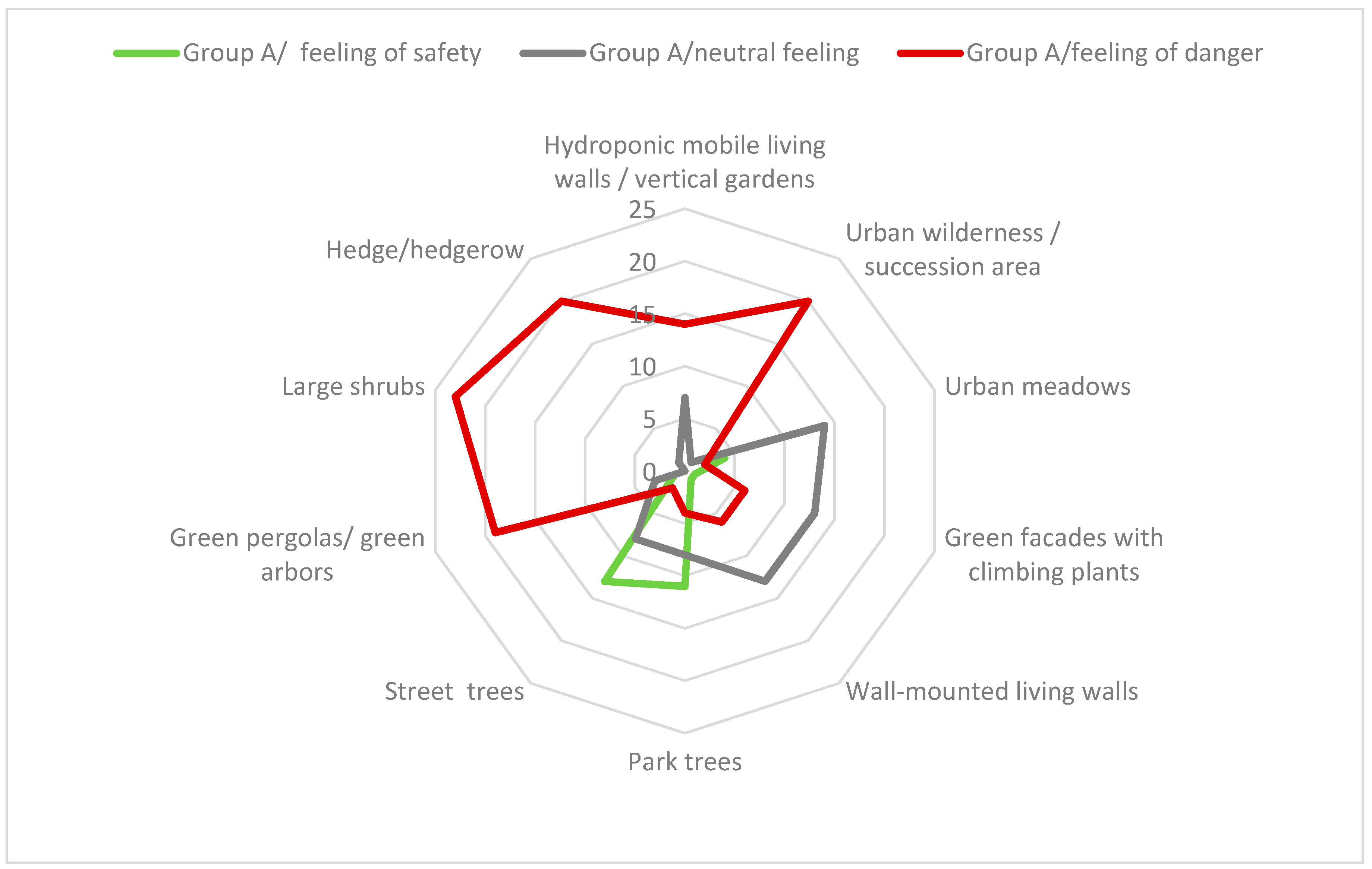
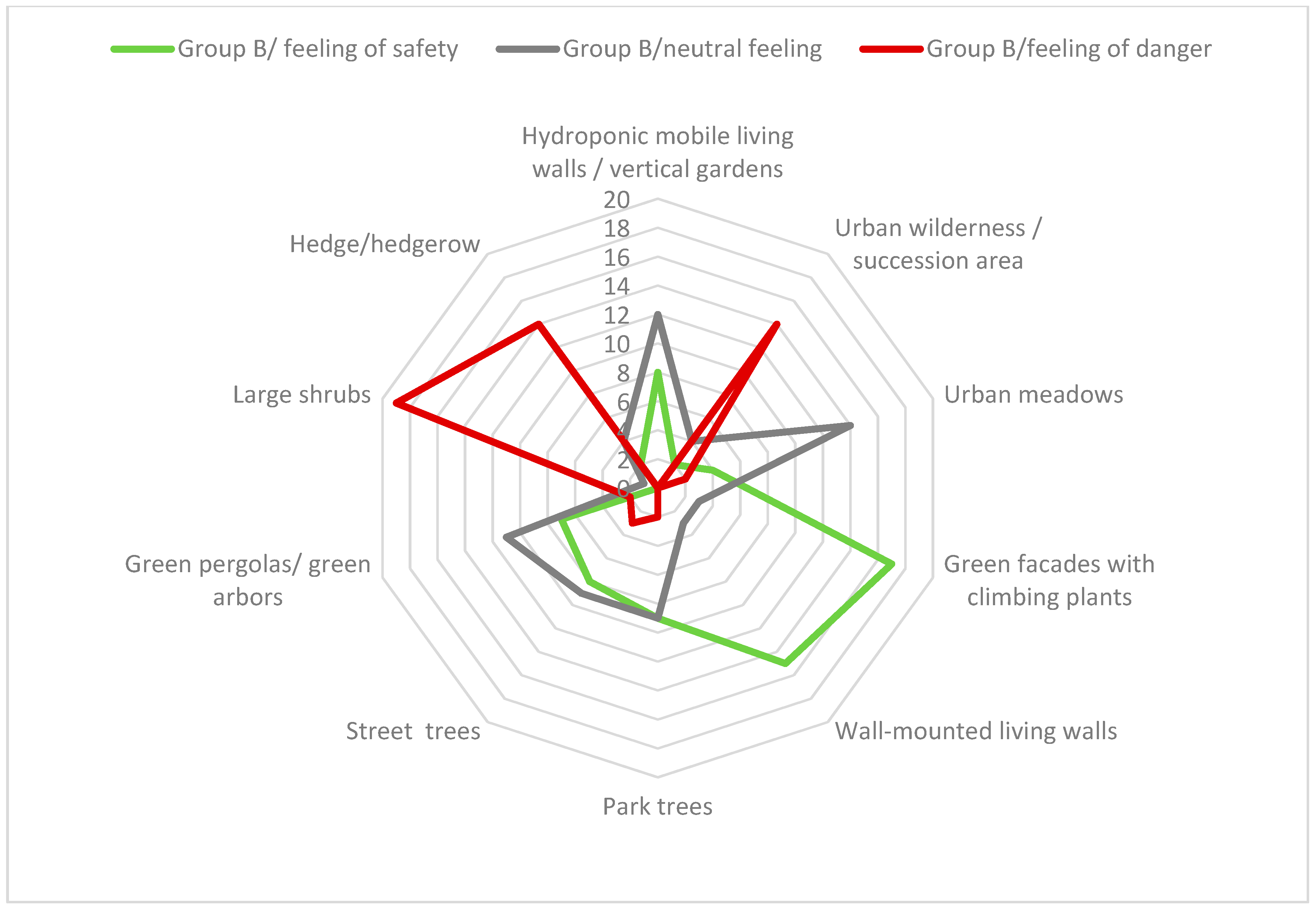
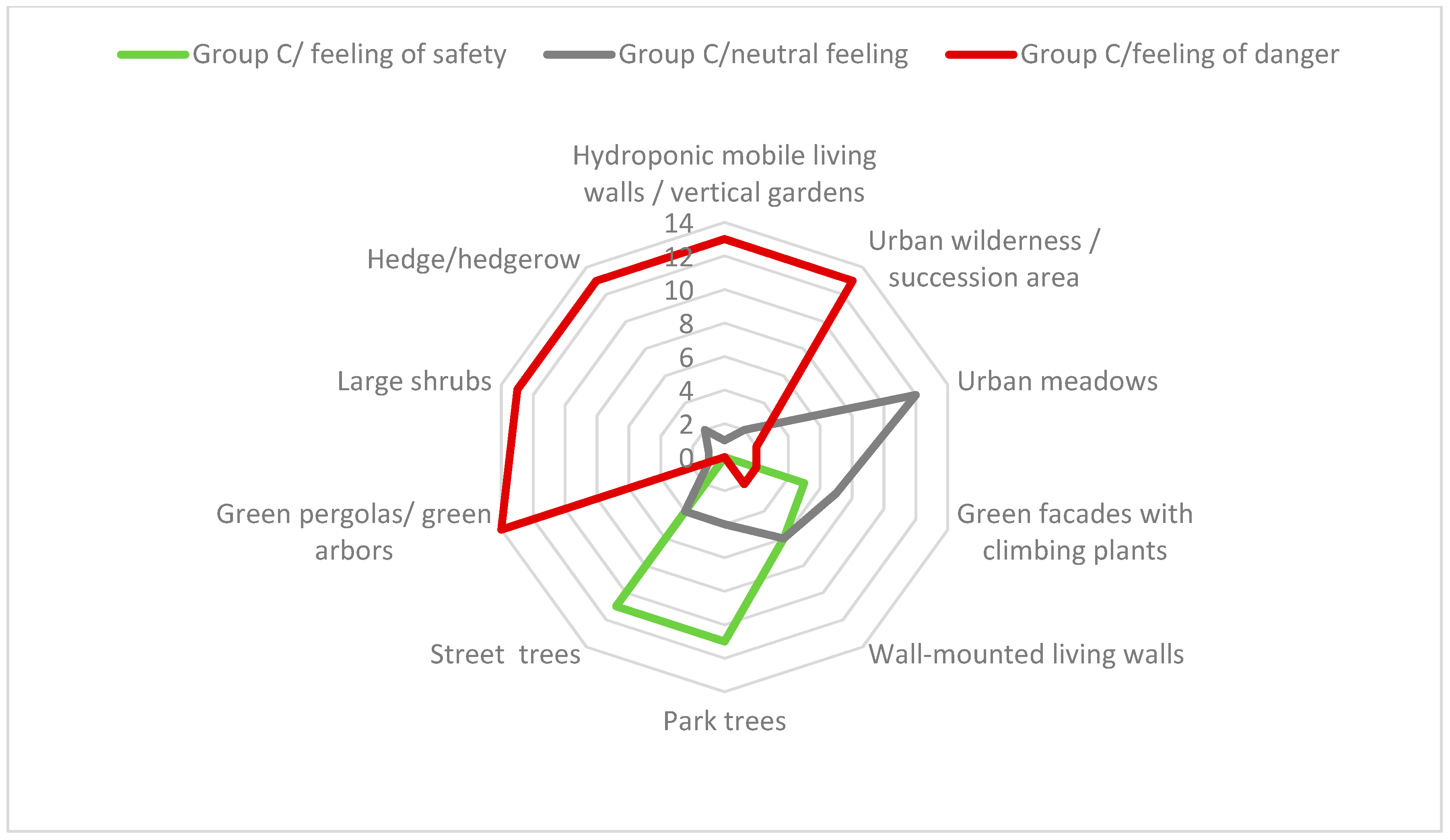
| Dominant Effect | Partial Effect | Additional Effect (Has Another Dominant Function) |
|---|---|---|
| Street trees | Urban meadows | Rain gardens (under-drained) |
| Park trees | Verges/flower beds with native perennials | Road-side swales for retention and infiltration |
| Fruit trees/shrubs/ | Ground cover plants | Linear wetlands for stormwater filtration |
| Large shrubs | Lawn | Rockery |
| Hedge/hedgerow | Green pavements | Herb spiral |
| Green pergolas/green arbours | Ground crops of vegetables/herbs | |
| Green facades with climbing plants | VRSS slopes with green fences | Rain gardens in planter (=self-contained) |
| Wall-mounted living walls | Green covering shelters | Street planters (as green street furniture) |
| Hydroponic mobile living walls/vertical gardens | ||
| Vertical vegetable/herb gardens | ||
| Hanging wall planters (as green street furniture) | ||
| Green roof/roof terrace | ||
| Urban wilderness/succession area |
| Types of NBS | Comments |
|---|---|
| Street trees | Leaves fall from the trees, and it is not clear who will take care of them, but I do not feel any danger. |
| Park trees | Leaves fall from the trees, and it is not clear who will take care of them. Will junkies gather here? |
| Fruit trees/shrubs | Children would climb trees and injure themselves. |
| Large shrubs | In no case, someone can hide behind a shrub, or it will be used as a toilet. |
| Hedge/hedgerow | There may be a thief or worse hidden behind it. |
| Green pergolas/green arbours | There will be toilets, and homeless people will gather around. |
| Green facades with climbing plants | I am worried about the technical solution so that it does not fall on anyone |
| Wall-mounted living walls | I am worried about the technical solution so that it does not fall on anyone. |
| Hydroponic mobile living walls/vertical gardens | I am worried about the technical solution so that it does not fall on anyone. |
| Vertical vegetable/herb gardens | Anyway, someone will destroy it right away and what will grow there will be stolen. |
| Hanging wall planters (as green street furniture) | It will not last long before someone destroys it. |
| Green roof/roof terrace | I‘I am afraid the roof is not able to carry it. |
| Urban wilderness/succession area | Junkies would gather there. |
| Type of NBS | Average Value for Ostrava | Respondent Comments of the Part of Upper Silesian Agglomeration |
|---|---|---|
| Large shrubs | 2.959524 | Large bushes are part of, for example, Piastowski Square, forming a noise barrier. Its concept is close to urban wilderness. On this particular site, residents would welcome the retention of shrubs, but landscaped. Some respondents consider the placement of new large shrubs in a vacant gap in the development, for example, to be inappropriate concerns to raise. They are also concerned about large shrubs in a park area and near playgrounds. |
| Hedge/hedgerow | 2.806349 | A group of respondents on a particular street (11. November Street) were negative about putting trees on the street because they were concerned about overshadowing but would welcome a green fence which they did not consider risky. A green fence would separate the road from the pedestrian area. |
| Urban wilderness/succession area | 2.806349 | Respondents generally understood the importance of such an element for biodiversity and other positive attributes. The NIMBY syndrome was evident here. For no particular site, this NBS was proposed by residents who were concerned about creating space for troubled citizens. |
| Green pergolas/green arbours | 2.488647 | Respondents suggested pergolas for the courtyard area. All yards were private or semi-private spaces. Respondents did not feel apprehensive about pergolas in the courtyards. No pergola was proposed for a purely public space. |
| Vertical vegetable/herb gardens | 2.435229 | This NBS was proposed by respondents for a backyard area. All yards were either a private or semi-private space. As none of the sites in the public space discussed were suitable for growing vegetables, this NBS was not discussed by respondents from a safety perspective. |
| Hydroponic mobile (flexible) living walls/vertical gardens | 2.398413 | Respondents were positive about mobile living walls. In a few places, they even suggested them as a barrier to traffic. They felt no fear in relation to these NBS. |
| Hanging wall planters (as green street furniture) | 2.027359 | This NBS was proposed by respondents for a backyard area. All yards were either a private or semi-private space. Because none of the locations in the public space discussed were suitable for growing vegetables or herbs, this NBS was not discussed with respondents from a safety perspective |
| Urban meadows | 1.980952 | In several places, respondents suggested this type of NBS. Primarily, these were spaces today consisting of only a lawn. Often in front of shopping centres or as part of a square or park. |
| Fruit trees/shrubs | 1.800265 | Fruit trees were not proposed by respondents for any of the selected sites. Therefore, this NBS was not discussed with the respondents in terms of their safety. |
| Green facades with climbing plants | 1.728571 | Respondents in several places suggested a green facade as an appropriate solution. They felt no fear in connection with this element. |
| Wall-mounted living walls | 1.710317 | Respondents suggested this NBS for several places as an appropriate solution. They have no worries about this element. |
| Park trees | 1.53744 | A willow tree was suggested as an appropriate tree by several respondents. Willow is considered by respondents to be a very decorative tree that is also a native species. They have no fear of allergens. |
| Street trees | 1.512802 | Respondents (as indicated for the large bush section) do not want to have trees planted in their streets because they do not want to reduce the sunshine in their homes. They have no negative feelings about trees in terms of danger. |
| Green roof/roof terrace | 1.376409 | According to respondents, green roofs are very costly; therefore, they have not been proposed for any site. However, respondents reported a positive experience with green roofs in the agglomeration area. |
Publisher’s Note: MDPI stays neutral with regard to jurisdictional claims in published maps and institutional affiliations. |
© 2022 by the authors. Licensee MDPI, Basel, Switzerland. This article is an open access article distributed under the terms and conditions of the Creative Commons Attribution (CC BY) license (https://creativecommons.org/licenses/by/4.0/).
Share and Cite
Vojvodíková, B.; Tichá, I.; Starzewska-Sikorska, A. Implementing Nature-Based Solutions in Urban Spaces in the Context of the Sense of Danger That Citizens May Feel. Land 2022, 11, 1712. https://doi.org/10.3390/land11101712
Vojvodíková B, Tichá I, Starzewska-Sikorska A. Implementing Nature-Based Solutions in Urban Spaces in the Context of the Sense of Danger That Citizens May Feel. Land. 2022; 11(10):1712. https://doi.org/10.3390/land11101712
Chicago/Turabian StyleVojvodíková, Barbara, Iva Tichá, and Anna Starzewska-Sikorska. 2022. "Implementing Nature-Based Solutions in Urban Spaces in the Context of the Sense of Danger That Citizens May Feel" Land 11, no. 10: 1712. https://doi.org/10.3390/land11101712
APA StyleVojvodíková, B., Tichá, I., & Starzewska-Sikorska, A. (2022). Implementing Nature-Based Solutions in Urban Spaces in the Context of the Sense of Danger That Citizens May Feel. Land, 11(10), 1712. https://doi.org/10.3390/land11101712









